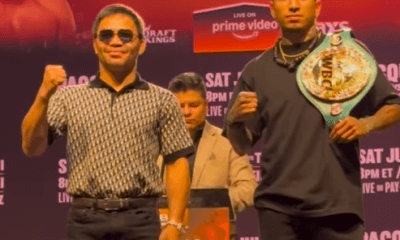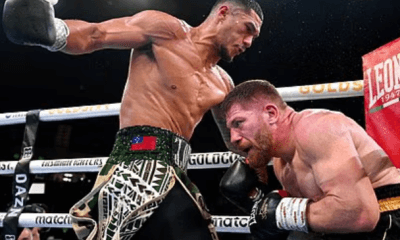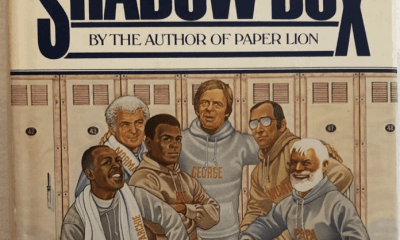Featured Articles
Small Consolation for Plant-Eaters
 In the early nineties, I was one of a ragtag band of boxers who trained at the Boston YMCA on Huntington Avenue. Sparring matches were held on Monday, Wednesday, and Friday evenings and were closely monitored by licensed trainers. After hours, when they had left the building, things got nasty. Renegade trainers drifted in and held unauthorized bouts where weight classes didn’t matter and headgear was frowned upon. There was blood on the walls. There was blood on the ceiling. One night I stood across the ring from an opponent who had a sculpted torso like Marvin Hagler, or come to think of it, Tim Bradley. You could grate Parmigiano-Reggiano on his abs.
In the early nineties, I was one of a ragtag band of boxers who trained at the Boston YMCA on Huntington Avenue. Sparring matches were held on Monday, Wednesday, and Friday evenings and were closely monitored by licensed trainers. After hours, when they had left the building, things got nasty. Renegade trainers drifted in and held unauthorized bouts where weight classes didn’t matter and headgear was frowned upon. There was blood on the walls. There was blood on the ceiling. One night I stood across the ring from an opponent who had a sculpted torso like Marvin Hagler, or come to think of it, Tim Bradley. You could grate Parmigiano-Reggiano on his abs.
When the bell rang, I proceeded with caution. He was quick, and stepped in to land a flush right hand. I should have seen stars. But I didn’t. I threw a lazy jab on purpose to test his power again on my terms. He did as expected and countered with another right. I turned my head with it, riding it out to gauge its force. For a fighter—especially one who routinely fought for his life in underground smokers—what I learned in that first round was a great relief. He hit about as hard as Aunt Madge.
Privately after the bout, I asked him if he was a vegetarian. The question surprised him and he answered that he was. “Go and get yourself a steak,” I said. “Plant-eaters don’t beat carnivores.” He offered what I’m sure was an impressive oration about healthy protein alternatives like tofu and soybeans though I didn’t much know what he was talking about and my parting remark told him I didn’t much care: “Tofu ain’t flesh.”
Untold numbers in the holistic health field believe that human beings are natural herbivores; that our hands are designed for berry-picking, not holding down prey, and our so-called canines are too small and flat to tear out flesh. What’s more, they say that our digestive systems have not yet adapted to meat and cite studies connecting obesity, heart disease, and other health risks to the delicatessen. Under the glaring light of new science, my flip remarks look like medieval superstition. Or do they? Within a few months, my opponent became less enlightened. He added red meat to his diet. Already quick-fisted with sound technique, his punching power was soon denting my ribs and we both knew why.
Civilians have every reason to eat tofu and beans in lieu of meat; to build their lifestyles around health consciousness, comfort, and self-preservation. They have every reason to stay out of boxing rings. But don’t mistake a civilian for a fighter. Humanist Dr. Harold Hillman doesn’t. He identifies what he calls the “vegetarian conscience” and lists activities that “vegetarian personalities” could be logically expected to vigorously oppose. Between “child labor” and “infanticide” sits “boxing.” In his defense, I suspect that his ability to appreciate the sweet science is no more advanced than my ability to appreciate the sedentary lifestyle of a soft-bellied academic.
Sugar Ray Robinson’s decidedly anti-humanist achievement of knocking out ninety-seven men would horrify Hillman. His carnivorous habits would have called for smelling salts to revive Hillman. At a contract-signing luncheon in Chicago before his sixth match against Jake LaMotta in 1951, Robinson asked the waiter for a big glass of beef blood. The waiter was as confused as LaMotta was disturbed. “I’ll get you some extra gravy right away,” he said. “No, not the gravy,” Robinson corrected him. “The actual blood, the blood in the meat before it’s cooked.” When the glass was set down before him, he turned to LaMotta. “It’s what makes a skinny guy like me so strong,” he said as he added just a pinch of salt and pepper.
“You’re outta your mind,” said LaMotta.
To the uninitiated, anyone who gets into the ring is “outta his mind.” Indeed; if self-preservation and material pursuits are all that matters, then risking one’s life for a chance at glory can only be insane.
It’s been over ten years since the Huntington Avenue YMCA in Boston ended its boxing program. Odds are 4-1 that the executive director at the time was a vegetarian.
Saturday night, 4-1 underdog Tim Bradley was given a dubious decision over Manny Pacquiao. I predicted a knockout of the most violent sort and though I didn’t mention it, part of my reasoning was rooted in the same evidence-based superstition that prompted me to warn my opponent all those years ago: Plant-eaters don’t beat carnivores. Bradley is the picture of health and wellness. His discipline goes beyond that of mere vegetarianism during training camp, he becomes downright vegan and refrains from consuming any animal product. No meat. No fish. No milk. He makes the not-outlandish claim that all that green leafy stuff gives him a surplus of energy. I’m a believer. Had it not been for what hand-wringing academics deplore as a most unfortunate choice of occupations, he’d probably live to be a hundred and ten.
But he sure can’t hit.
Despite the fact that Bradley understands how to fight southpaws enough to move to his left, away from their power line, his offense was of the “get off me!” variety. It reminded me of those Animal Planet episodes where a soon-to-be consumed herbivore flails in a panic just before the beast clamps down on its throat. Pacquiao stalked without fear and shook off left hooks and right hands like a prep cook would wet lettuce.
I watched the bout three times in a vain attempt to see how it was that the judges decided in favor of the plant-eater. “I thought Bradley gave Pacquiao a boxing lesson,” said Las Vegas judge Duane Ford. “I went in with a clear mind.” That’s hard to reconcile given that Bradley was out landed by Pacquiao in ten of twelve rounds. The scattered punches that Bradley did manage to land inflicted no damage and the fact that he landed only 19% of them confirms that they weren’t much more than panicky flurries. Panicky flurries constitute neither “clean, effective punching” nor “effective aggression,” both of which are a major part of the judging criteria. My scorecard was 117-112 for Pacquiao.
That knockout I predicted was there all night. Had Pacquiao reversed his direction—had he simply went right instead of left—those left blasts he landed would have ended matters once and for all. He gave Bradley the assist he needed because he wasn’t positioning his back foot in front of Bradley’s chin in a straight line, in the power line. As it was, Pacquiao and the newly-inducted Hall of Fame trainer Freddie Roach neither saw nor made the adjustment. The lion circled the lamb in the wrong direction but proved it was a lion, and the lamb flailed, survived, and took a split decision that defies explanation.
Then again, perhaps none of Saturday night’s blunders defy explanation. According to holistic gurus, meat promotes over-acidification of the body and one of the symptoms is unclear thinking. In that case, someone needs to check the books at Tom Coliccio’s Craftsteak at the MGM Grand, where the portions are big and the porterhouse is still breathing. Four-to-one says judges Ford and CJ Ross have standing reservations from way back.
June 10, 2012
____________________________
Springs Toledo can be contacted at scalinatella@hotmail.com“>scalinatella@hotmail.com.
-

 Featured Articles3 weeks ago
Featured Articles3 weeks agoAvila Perspective, Chap. 330: Matchroom in New York plus the Latest on Canelo-Crawford
-

 Featured Articles2 weeks ago
Featured Articles2 weeks agoVito Mielnicki Jr Whitewashes Kamil Gardzielik Before the Home Folks in Newark
-

 Featured Articles4 weeks ago
Featured Articles4 weeks agoAvila Perspective, Chap 329: Pacquiao is Back, Fabio in England and More
-

 Featured Articles3 weeks ago
Featured Articles3 weeks agoOpetaia and Nakatani Crush Overmatched Foes, Capping Off a Wild Boxing Weekend
-

 Featured Articles2 weeks ago
Featured Articles2 weeks agoCatching Up with Clay Moyle Who Talks About His Massive Collection of Boxing Books
-

 Featured Articles4 weeks ago
Featured Articles4 weeks agoFabio Wardley Comes from Behind to KO Justis Huni
-

 Featured Articles1 week ago
Featured Articles1 week agoMore Medals for Hawaii’s Patricio Family at the USA Boxing Summer Festival
-

 Featured Articles4 weeks ago
Featured Articles4 weeks agoDelving into ‘Hoopla’ with Notes on Books by George Plimpton and Joyce Carol Oates















